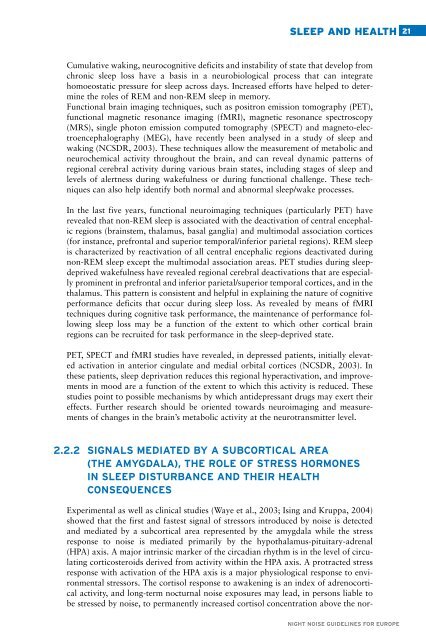Night noise guidelines for Europe - WHO/Europe - World Health ...
Night noise guidelines for Europe - WHO/Europe - World Health ...
Night noise guidelines for Europe - WHO/Europe - World Health ...
Create successful ePaper yourself
Turn your PDF publications into a flip-book with our unique Google optimized e-Paper software.
SLEEP AND HEALTH 21<br />
Cumulative waking, neurocognitive deficits and instability of state that develop from<br />
chronic sleep loss have a basis in a neurobiological process that can integrate<br />
homoeostatic pressure <strong>for</strong> sleep across days. Increased ef<strong>for</strong>ts have helped to determine<br />
the roles of REM and non-REM sleep in memory.<br />
Functional brain imaging techniques, such as positron emission tomography (PET),<br />
functional magnetic resonance imaging (fMRI), magnetic resonance spectroscopy<br />
(MRS), single photon emission computed tomography (SPECT) and magneto-electroencephalography<br />
(MEG), have recently been analysed in a study of sleep and<br />
waking (NCSDR, 2003). These techniques allow the measurement of metabolic and<br />
neurochemical activity throughout the brain, and can reveal dynamic patterns of<br />
regional cerebral activity during various brain states, including stages of sleep and<br />
levels of alertness during wakefulness or during functional challenge. These techniques<br />
can also help identify both normal and abnormal sleep/wake processes.<br />
In the last five years, functional neuroimaging techniques (particularly PET) have<br />
revealed that non-REM sleep is associated with the deactivation of central encephalic<br />
regions (brainstem, thalamus, basal ganglia) and multimodal association cortices<br />
(<strong>for</strong> instance, prefrontal and superior temporal/inferior parietal regions). REM sleep<br />
is characterized by reactivation of all central encephalic regions deactivated during<br />
non-REM sleep except the multimodal association areas. PET studies during sleepdeprived<br />
wakefulness have revealed regional cerebral deactivations that are especially<br />
prominent in prefrontal and inferior parietal/superior temporal cortices, and in the<br />
thalamus. This pattern is consistent and helpful in explaining the nature of cognitive<br />
per<strong>for</strong>mance deficits that occur during sleep loss. As revealed by means of fMRI<br />
techniques during cognitive task per<strong>for</strong>mance, the maintenance of per<strong>for</strong>mance following<br />
sleep loss may be a function of the extent to which other cortical brain<br />
regions can be recruited <strong>for</strong> task per<strong>for</strong>mance in the sleep-deprived state.<br />
PET, SPECT and fMRI studies have revealed, in depressed patients, initially elevated<br />
activation in anterior cingulate and medial orbital cortices (NCSDR, 2003). In<br />
these patients, sleep deprivation reduces this regional hyperactivation, and improvements<br />
in mood are a function of the extent to which this activity is reduced. These<br />
studies point to possible mechanisms by which antidepressant drugs may exert their<br />
effects. Further research should be oriented towards neuroimaging and measurements<br />
of changes in the brain’s metabolic activity at the neurotransmitter level.<br />
2.2.2 SIGNALS MEDIATED BY A SUBCORTICAL AREA<br />
(THE AMYGDALA), THE ROLE OF STRESS HORMONES<br />
IN SLEEP DISTURBANCE AND THEIR HEALTH<br />
CONSEQUENCES<br />
Experimental as well as clinical studies (Waye et al., 2003; Ising and Kruppa, 2004)<br />
showed that the first and fastest signal of stressors introduced by <strong>noise</strong> is detected<br />
and mediated by a subcortical area represented by the amygdala while the stress<br />
response to <strong>noise</strong> is mediated primarily by the hypothalamus-pituitary-adrenal<br />
(HPA) axis. A major intrinsic marker of the circadian rhythm is in the level of circulating<br />
corticosteroids derived from activity within the HPA axis. A protracted stress<br />
response with activation of the HPA axis is a major physiological response to environmental<br />
stressors. The cortisol response to awakening is an index of adrenocortical<br />
activity, and long-term nocturnal <strong>noise</strong> exposures may lead, in persons liable to<br />
be stressed by <strong>noise</strong>, to permanently increased cortisol concentration above the nor-<br />
NIGHT NOISE GUIDELINES FOR EUROPE

















